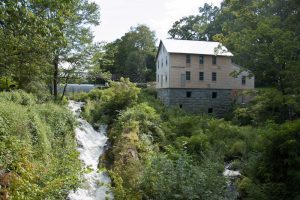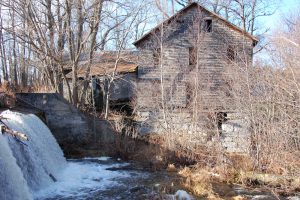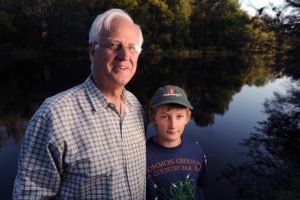Mill of Dreams
Sustainability entrepreneur Tony Grassi brought an historic Maine mill back to life
One of the first things Tony Grassi will do when he gives his Monday, October 23 Mitchell Center Sustainability Talk is make a slight adjustment to the talk’s title, “Build it and they will come.”

“I’m going to start my talk with a disclaimer,” says Grassi, who led the effort to save and restore the nearly 200-year-old Mill at Freedom Falls, Maine that was teetering on the verge of collapse in 2004 when he first encountered the granite and timber frame structure.
“When the Mitchell Center folks and I were trying to think of something catchy for the title, we felt most people would recognize a modified version of the famous line from the movie Field of Dreams—’If you build it, he will come,”” Grassi says. “But, in fact, the story of the mill is actually ‘if you rebuild it, they will come.’ The whole idea was to not build something new.”
And come they have. The restored, water-powered grist mill, which had been vacant and decaying for more than four decades, has become a showcase of sustainability and has helped drive the revitalization of the Village of Freedom.
Grassi will talk about sustainability in practice as he and his wife, Sally, rehabilitated the mill, restored hydropower at the old dam using cutting-edge turbine technology, and, inside the mill, became home to an innovative, hands-on school—The Mill School—as well as Belfast’s Lost Kitchen restaurant, which shuttered its doors in 2011.
In his talk, Grassi will detail what he learned during a process that spanned over a decade from his initial vision to the mill’s transfiguration in late 2014. He will talk about the complications, pitfalls and rewards of investing in sustainability.
“From the process of revitalizing the old mill I learned a number of things,” Grassi says, “I learned that local support is critical and that if you are what I would call ‘well-intentioned,’ the regulators can be incredibly supportive and creative in helping you think through and resolve the various issues that inevitably arise. That has been a very pleasant revelation.”
Another pleasant lesson learned, Grassi notes, is that well-intentioned efforts can be well rewarded.
“Maybe we’re just lucky,” Grassi says of he and Sally, “but over the years I’ve found that doing good has in fact resulted in doing well financially. And that I think includes a willingness to accept other measures besides return on investment. By not pushing to maximize every nickel, it made the project doable. We may have sacrificed a little bit of financial return, but in this case it enabled us to do significantly better on the non-financial rewards.”
Those rewards, Grassi notes, include enhancement of community, and in this specific case support for the farming community and the educational community, and incorporating developing technologies for use of hydropower in an environmentally friendly way.

Sustainable, run-of-the-river hydropower
In an effort to use the Freedom Falls watershed as sustainably as possible, Grassi partnered with California-based Natel Energy, developer of a state-of-the-art hydropower turbine designed to more economically generate electricity with lower flow rates of water compared to conventional turbines. The company was founded by a brother and sister team of MIT engineers. Its first commercial customer was Apple Computer, which is using Natel’s “Free-Jet hydroEngine” turbine to lower its carbon footprint and help power one of its data centers. The company’s second commercial customer was The Mill at Freedom Falls.
“We wanted hydropower that didn’t adversely affect the local stream and watershed environment so we designed the system to be run-of-the river, Grassi says. “We are not managing the water flow and here’s an example of not maximizing every nickel. If we’d tried to step up the hydropower values we would have done a variety of things, including perhaps expanding the pond behind the dam to its old foot print, fixing an intermediate upstream dam and managing the water in the 15 acres above the dam. We could have done a lot to increase the financial returns.”
But in the end, such an approach wasn’t worth it and it certainly didn’t fit in with the spirit of the project. “We thought we could encourage the development of new technologies and the potential replication of this concept in other locations around the world.”
Indeed, Grassi adds, Natel has been in conversation with cabinet-level representatives from the Kingdom of Bhutan on the eastern edge of the Himalayas about using the turbine technology to harness the power of Himalayan streams and rivers.
The Mill School, too, could be said to take a “run-of-the-river” approach to part of its curricula. The school was founded by Grassi’s daughter Laurie Grassi Redmond, who serves as one of two teachers for the 20 students who attend three days a week in grades one through eight. Its place-based or experiential educational style seeks to connect learning with local history, environment, and culture.
Notes Redmond in the film “Reviving the Freedom Mill” by Compass Light Productions, “Based on the notion of place-based education, (at the Mill School) children can connect to themselves and to each other and their family and the community sort of going out in concentric circles” like ripples in water in the wake of a tossed stone.
Says Grassi, “There’s no question this is a magical environment for schooling. I haven’t had an adult walk through who didn’t say ‘I wish I’d gone to a school like this.’ And the curriculum is very much centered around the pond, the stream, the Mill as a laboratory, if you will, for the kids.” All five of Grassi’s grandchildren have attended The Mill School.

Creating a sustainability vision for rural communities
Based on his experience in Freedom, Grassi believes the way towards creating a sustainability vision in a rural setting is for “people to come together in a forward-looking way and think about what they want to be when ‘they grow up.’ What are their strengths and weaknesses, what are the natural resources available to them, what will lead to a sustainable community model?”
That said, he notes that in his case with the Mill, the process was a bit backwards—he showed up as an outsider with a sustainability project in mind ahead of any broad community discussion about crafting a sustainable future.
And did he encounter a lot of initial resistance to his “outsider” vision? Not so much.
“And there are two reasons for that,” Grassi says. “The most important is that while I was an outsider, my son Prentice and daughter-in-law Polly Shyka were a significant presence in the community so in that sense maybe we got a pass. And the other reason was that I wasn’t preaching a vision to the community, I was saying ‘You have an incredible asset, an incredibly beautiful building here, and we want to save it.”
The effort also saved The Lost Kitchen, the acclaimed locavore restaurant formerly in Belfast established by chef Erin French who grew up in Freedom just two miles from the mill. The Lost Kitchen in Belfast shut down in 2011 and opened again as a “destination restaurant” in Freedom in 2013. Grassi credits French and her restaurant with “helping put the town of Freedom on the map.”
“We provided the vehicle, the restored mill building, and I think Erin would be the first to say this could not have worked without the vehicle, that a part of her success is the place itself. But it’s because of her vision and her farm-to-table approach that this works so beautifully,” Grassi says. He adds, “And her sense of style – like the way she decorates with local flowers, herbs and vegetables – really is a perfect mesh with this restored stone and wood structure.”
The final chapter in the story of the rebirth of the Mill at Freedom Falls has not been written, according to Grassi.
“It’s yet to be told whether this investment is like a rising tide that will lift more boats in Freedom and beyond with respect to sustainable growth, community resilience, renewable energy and the like. We don’t know the answer to that yet,” Grassi says. He adds, “But I guess I believe that if that’s not the case in my lifetime that’s okay. We’ve taken an incredibly beautiful old building and given it another 200 years of life.”
—David Sims
